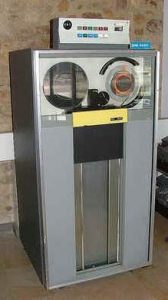IBM 3420 tape storage family
International Business Machines Co. ( IBM ) began producing magnetic tape storage devices in 1970. The two main units of the data storage family were the controller with code number 3803 and the tape drive with code number 3420 (picture). The latter came in three 7- and 9-track models, with model numbers 3, 5, 7, and 4, 6, 8, respectively. They differed only in their technical parameters; their operating principles were the same and they also looked the same.
Use
Large-scale “off-line” data storage.
IBM computer-powered data centers
Structure
The data storage devices consisted of two main units:
- Aconveyor mechanicsIt rotated the tape reels around two horizontal axes, unwinding the magnetic tape from one and winding it onto the other, passing in front of the read/write and erase heads. Its most important components
- lowering motor
- winding motor
- capstan motor, in front of the heads to maintain a very precisely constant tape speed
- spindle locks on the shafts
- head unit, including the write/read head (in better quality devices, two separate heads are used, because a large coil is required for reading and a low impedance coil for writing), and the erase head
- various rollers to precisely maintain the tape path and to tension the tape sufficiently in front of the heads
- vacuum (rarefied) chamber for sucking in a belt loop (to compensate for temporary speed differences resulting from changes in direction of travel)
- Acontrol unit, which
- continuously regulated the proper rotation of the motors
- contained the electronic circuits necessary for writing, reading, and erasing
More important technical parameters:
- bit density per track:
- For 7-track tapes: 1600 bpi
- For 9-inch tapes: 6250 bpi
- tape speed: 120 – 200 inchps
- maximum transfer rate: 1.25 MBps
- tape length: up to 800 m (2400 ft)
Operation
The wound magnetic tape was enclosed in a plastic protective ring. This had to be removed before loading, then the reel was fixed on the left-hand shaft and the tape was threaded onto the empty reel on the right-hand side via the guide rollers. When the “automatic loading” function was started, a tape loop was sucked into the vacuum chamber to a depth determined by optical sensors until the optical sensor on the right-hand reel reached the “tape start” mark on the winding tape.
The 9-track magnetic tape was written byte by byte (8 bits + 1 parity bit, perpendicular to the track). A detailed description of its operation is available in: 9 track tape (English).
Program set
The controller's ROM memory contained about 1000 microprogrammed instructions, with these
- most of the tape operations were carried out in an autonomous mode
- prevented a drive from being used by multiple programs at the same time
- optimized tape tension and maximized operating speed by controlling the speed of the motors, thereby significantly increasing the writing density (see above)
- also performed on-the-fly diagnostic functions, such as
- automatically generated and checked the parity bit
- could correct up to two simultaneous errors
- detected and reported section faults
There were no
Historical curiosities
The ACM Digital Library refers to a study that details the history of the development of the IBM 3420 magnetic tape storage family and the parameters of the models.
Resources
Comparison table of models of the machine family: IBM 3420 (English)
Created: 2016.07.20. 16:40
Last modified: 2020.07.24. 12:04

